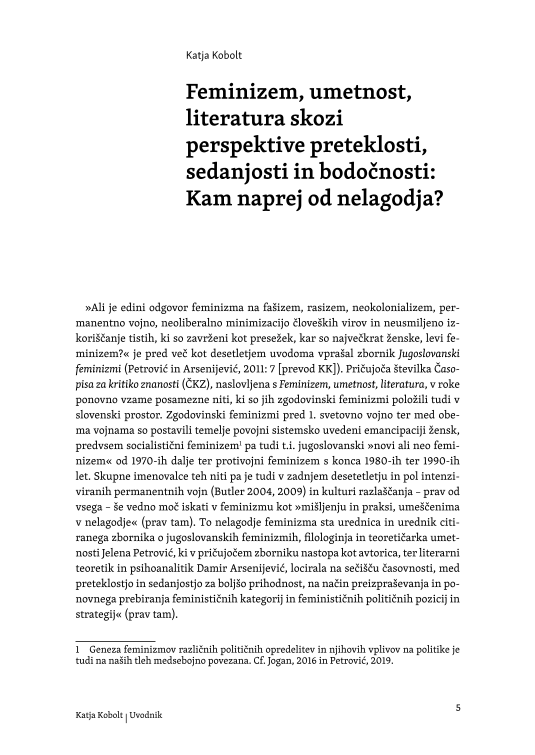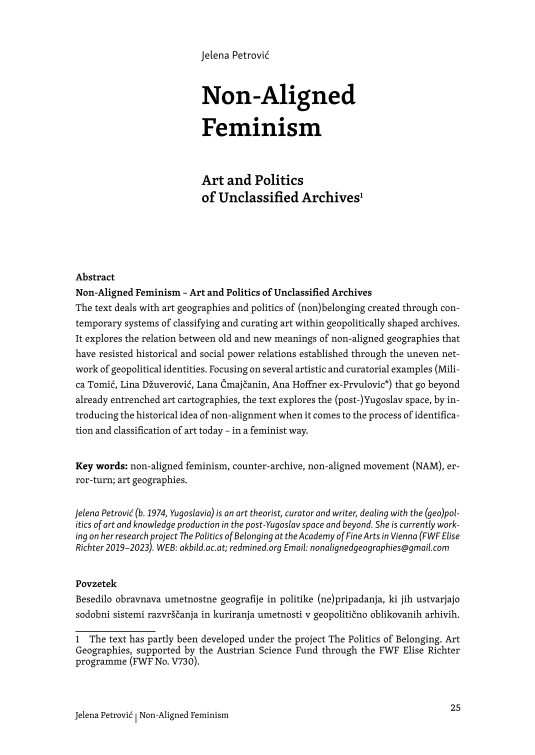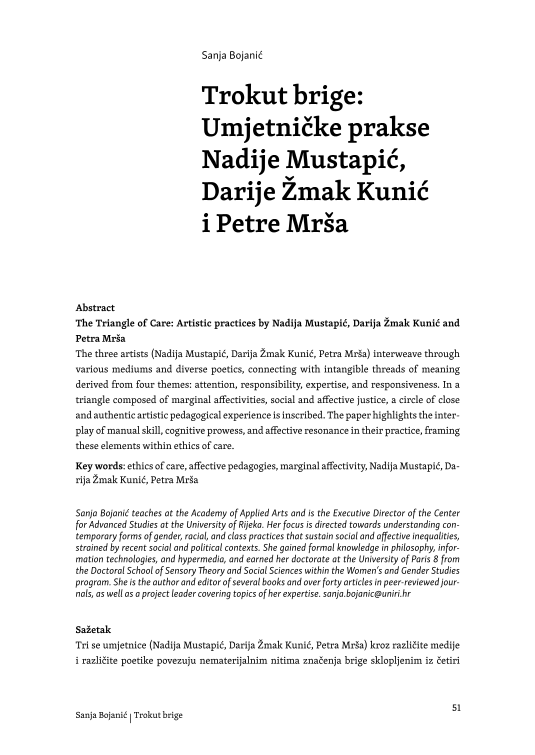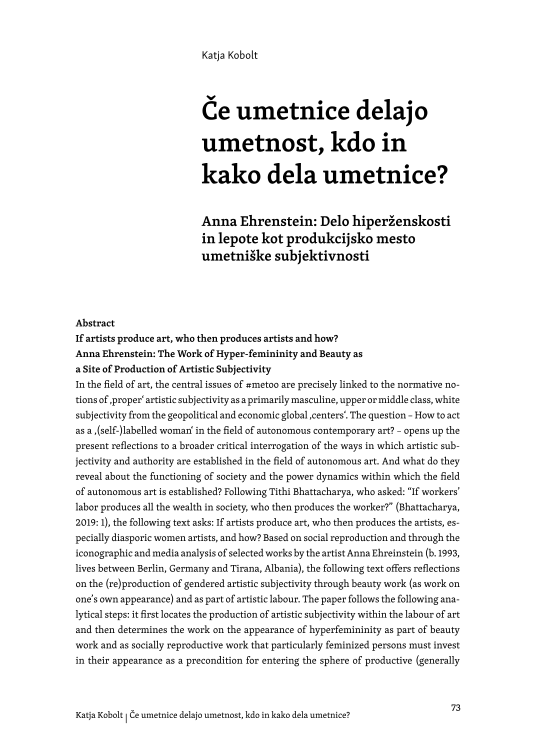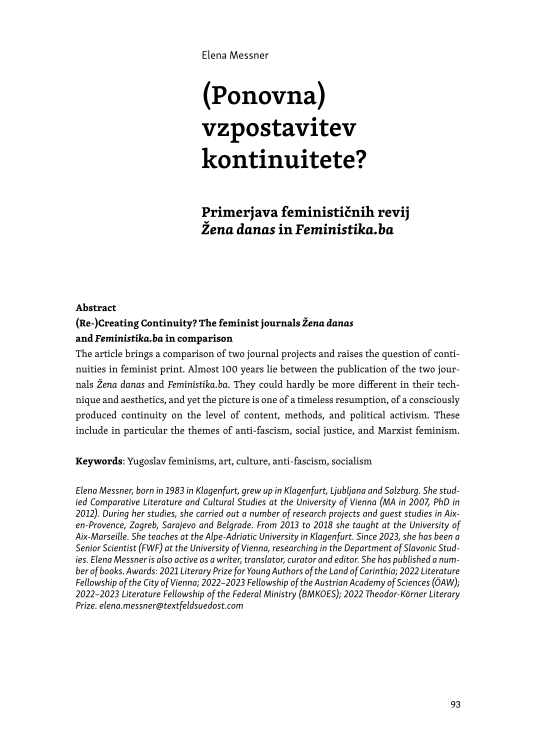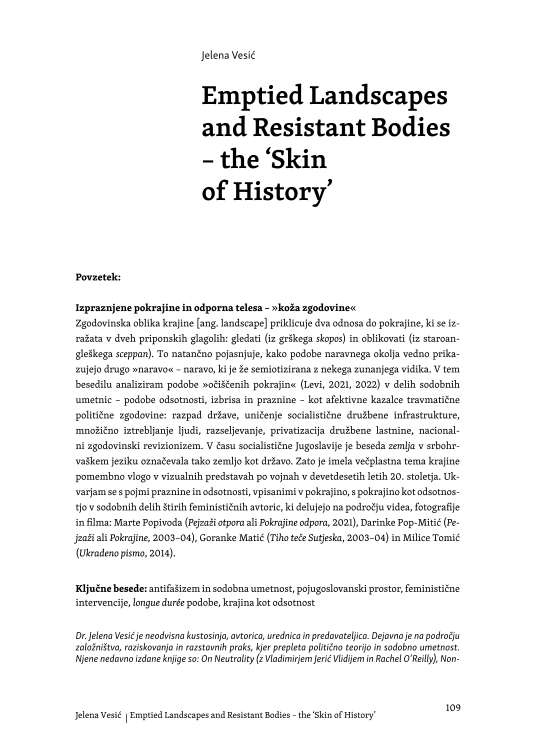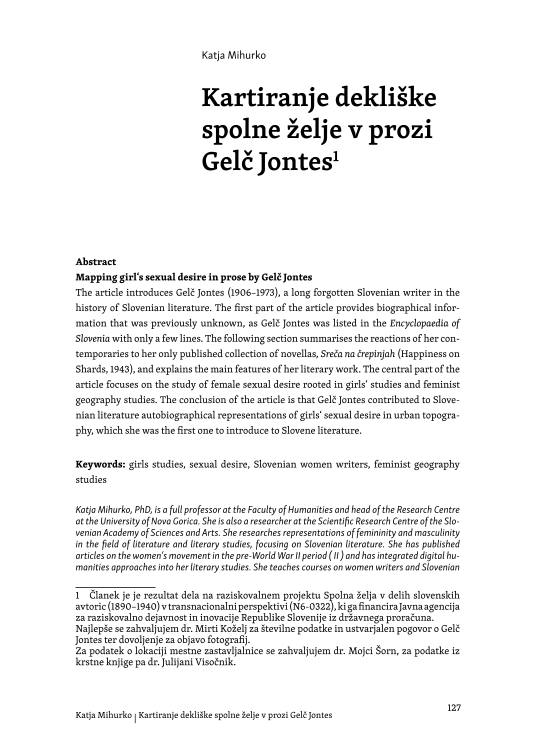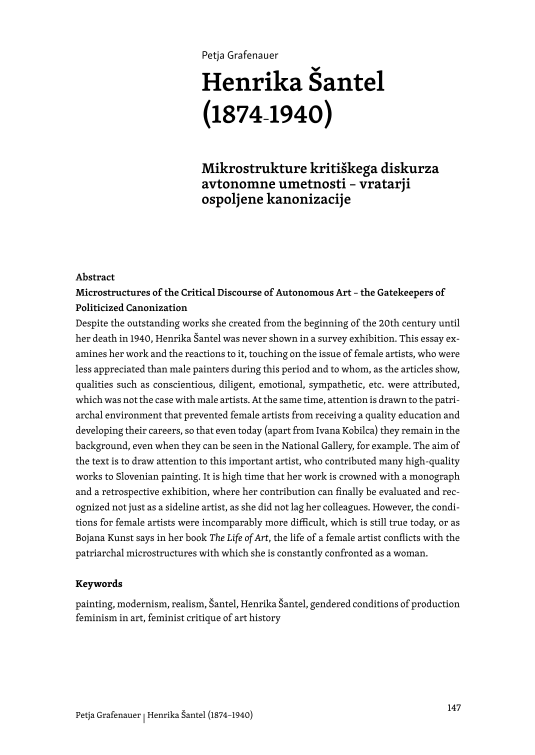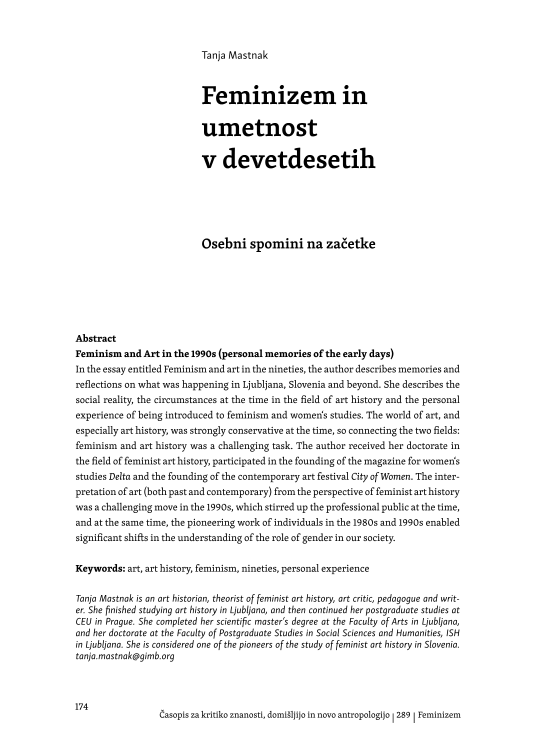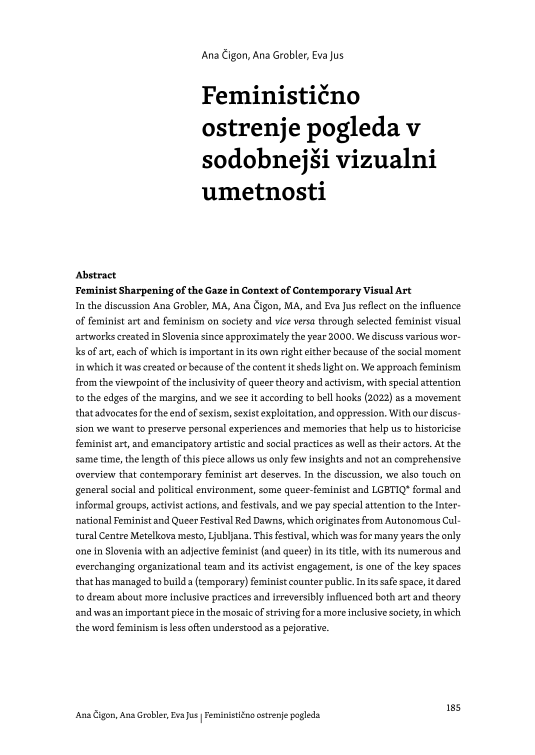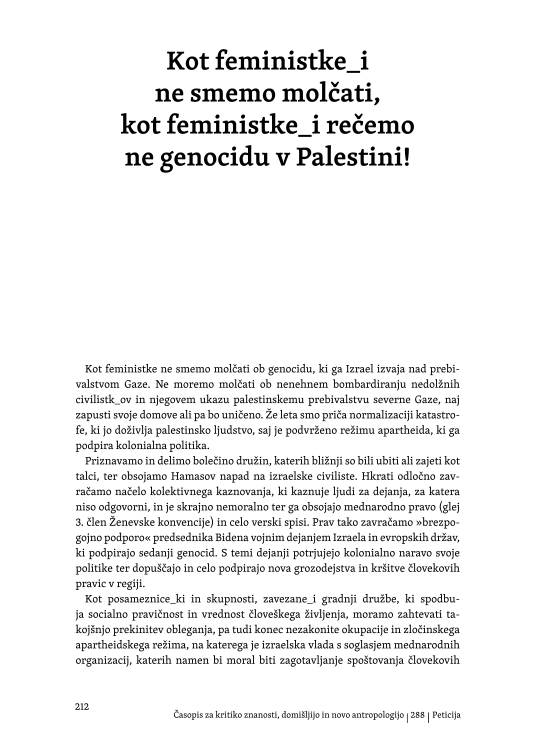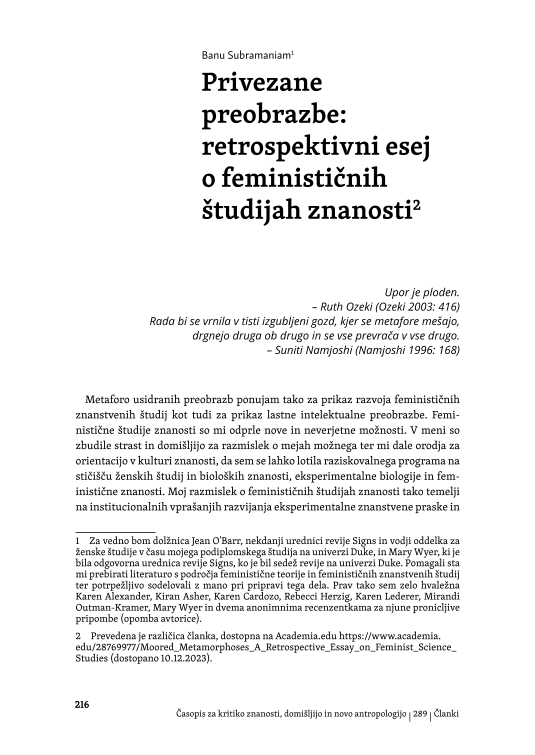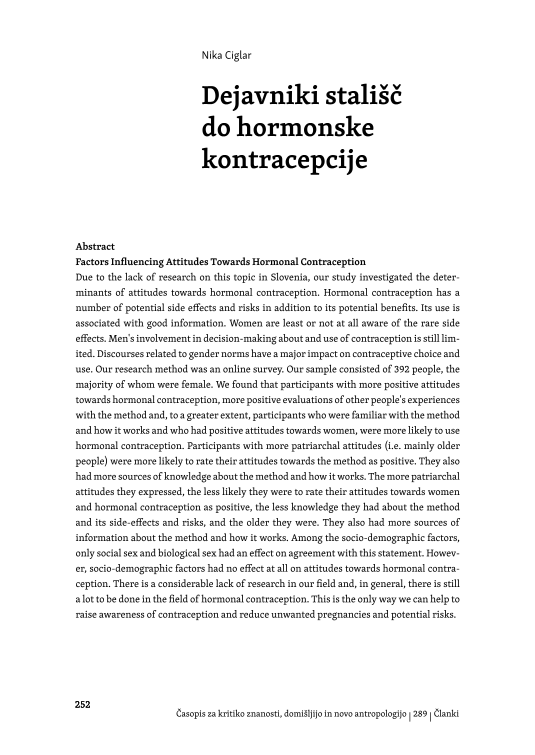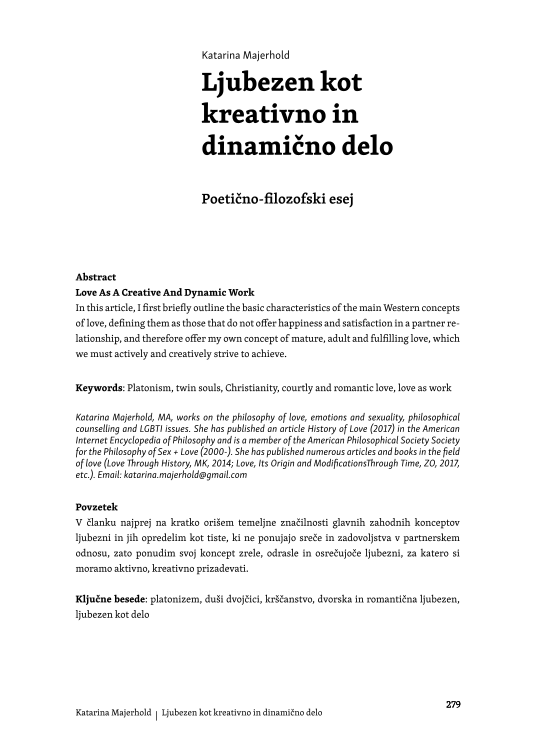»Ali je edini odgovor feminizma na fašizem, rasizem, neokolonializem, permanentno vojno, neoliberalno minimizacijo človeških virov in neusmiljeno izkoriščanje tistih, ki so zavrženi kot presežek, kar so največkrat ženske, levi feminizem?« je pred več kot desetletjem uvodoma vprašal zbornik Jugoslovanski feminizmi (Petrović in Arsenijević, 2011: 7 [prevod KK]). Pričujoča številka Časopisa za kritiko znanosti (ČKZ), naslovljena s Feminizem, umetnost, literatura, v roke ponovno vzame posamezne niti, ki so jih zgodovinski feminizmi položili tudi v slovenski prostor. Zgodovinski feminizmi pred 1. svetovno vojno ter med obema vojnama so postavili temelje povojni sistemsko uvedeni emancipaciji žensk, predvsem socialistični feminizem1 pa tudi t.i. jugoslovanski »novi ali neo feminizem« od 1970-ih dalje ter protivojni feminizem s konca 1980-ih ter 1990-ih let. Skupne imenovalce teh niti pa je tudi v zadnjem desetetletju in pol intenziviranih permanentnih vojn (Butler 2004, 2009) in kulturi razlaščanja – prav od vsega – še vedno moč iskati v feminizmu kot »mišljenju in praksi, umeščenima v nelagodje« (prav tam). To nelagodje feminizma sta urednica in urednik citiranega zbornika o jugoslovanskih feminizmih, filologinja in teoretičarka umetnosti Jelena Petrović, ki v pričujočem zborniku nastopa kot avtorica, ter literarni teoretik in psihoanalitik Damir Arsenijević, locirala na sečišču časovnosti, med preteklostjo in sedanjostjo za boljšo prihodnost, na način preizpraševanja in ponovnega prebiranja feminističnih kategorij in feminističnih političnih pozicij in strategij« (prav tam).
The text deals with art geographies and politics of (non)belonging created through contemporary systems of classifying and curating art within geopolitically shaped archives. It explores the relation between old and new meanings of non-aligned geographies that have resisted historical and social power relations established through the uneven network of geopolitical identities. Focusing on several artistic and curatorial examples (Mili- ca Tomić, Lina Džuverović, Lana Čmajčanin, Ana Hoffner ex-Prvulovic*) that go beyond already entrenched art cartographies, the text explores the (post-)Yugoslav space, by introducing the historical idea of non-alignment when it comes to the process of identification and classification of art today – in a feminist way.
The Triangle of Care: Artistic practices by Nadija Mustapić, Darija Žmak Kunić and Petra Mrša
(
The three artists (Nadija Mustapić, Darija Žmak Kunić, Petra Mrša) interweave through various mediums and diverse poetics, connecting with intangible threads of meaning derived from four themes: attention, responsibility, expertise, and responsiveness. In a triangle composed of marginal affectivities, social and affective justice, a circle of close and authentic artistic pedagogical experience is inscribed. The paper highlights the interplay of manual skill, cognitive prowess, and affective resonance in their practice, framing these elements within ethics of care.
In the field of art, the central issues of #metoo are precisely linked to the normative notions of ‚proper‘ artistic subjectivity as a primarily masculine, upper or middle class, white subjectivity from the geopolitical and economic global ‚centers‘. The question – How to act as a ‚(self-)labelled woman‘ in the field of autonomous contemporary art? – opens up the present reflections to a broader critical interrogation of the ways in which artistic subjectivity and authority are established in the field of autonomous art. And what do they reveal about the functioning of society and the power dynamics within which the field of autonomous art is established? Following Tithi Bhattacharya, who asked: “If workers’ labor produces all the wealth in society, who then produces the worker?” (Bhattacharya, 2019: 1), the following text asks: If artists produce art, who then produces the artists, especially diasporic women artists, and how? Based on social reproduction and through the iconographic and media analysis of selected works by the artist Anna Ehreinstein (b. 1993, lives between Berlin, Germany and Tirana, Albania), the following text offers reflections on the (re)production of gendered artistic subjectivity through beauty work (as work on one’s own appearance) and as part of artistic labour. The paper follows the following analytical steps: it first locates the production of artistic subjectivity within the labour of art and then determines the work on the appearance of hyperfemininity as part of beauty work and as socially reproductive work that particularly feminized persons must invest in their appearance as a precondition for entering the sphere of productive (generally paid) work. The article looks at hyperfemininity in the artworks under discussion from the point of view of how it establishes itself in connection with globalized visual culture and reflects on its social roles.
(Re-)Creating Continuity? The feminist journals Žena danas and Feministika.ba in comparison
(
The article brings a comparison of two journal projects and raises the question of continuities in feminist print. Almost 100 years lie between the publication of the two journals Žena danas and Feministika.ba. They could hardly be more different in their technique and aesthetics, and yet the picture is one of a timeless resumption, of a consciously produced continuity on the level of content, methods, and political activism. These include in particular the themes of anti-fascism, social justice, and Marxist feminism.
The historical form of the word landscape evokes two distinct relations to the land, expressed in two suffixed verbs: ‘to look at’ (derived from Greek skopein) and ‘to shape’ (derived from Old English sceppan). It explains exactly how images of the natural environment always display a ‘second nature’– the nature that is already semiotised from some external point of view. I analyse in this text the images of “cleansed landscapes” (Levi, 2021, 2022) in the works of contemporary female artists – images of absence, erasure and emptiness – as affective pointers to traumatic political histories: dissolution of the state and socialist social infrastructure, the mass extermination of people, displacement, privatisation of social property, and national historical revisionism. In socialist Yugoslavia, in the Serbo-Croatian language the word zemlja signified both the land (the soil) and the state. The layered topic of landscape therefore played a significant role in visual representations after the wars of the 1990s. In this article I engage with the notions of emptiness and absence inscribed in the landscape and with the landscape-as-absence in the contemporary works of four feminist authors working in video, photography and film: Marta Popivoda (Pejzaži otpora (Landscapes of Resistance), 2021), Darinka Pop-Mitić Pejzaži (Landscapes), 2003–04), Goranka Matić (Tiho teče Sutjeska (Softly Flows the Sutjeska), 2003–04), and Milica Tomić (Ukradeno pismo (The Purloined Letter), 2014).
The article introduces Gelč Jontes (1906–1973), a long forgotten Slovenian writer in the history of Slovenian literature. The first part of the article provides biographical information that was previously unknown, as Gelč Jontes was listed in the Encyclopaedia of Slovenia with only a few lines. The following section summarises the reactions of her contemporaries to her only published collection of novellas, Sreča na črepinjah (Happiness on Shards, 1943), and explains the main features of her literary work. The central part of the article focuses on the study of female sexual desire rooted in girls‘ studies and feminist geography studies. The conclusion of the article is that Gelč Jontes contributed to Slovenian literature autobiographical representations of girls‘ sexual desire in urban topography, which she was the first one to introduce to Slovene literature.
Despite the outstanding works she created from the beginning of the 20th century until her death in 1940, Henrika Šantel was never shown in a survey exhibition. This essay examines her work and the reactions to it, touching on the issue of female artists, who were less appreciated than male painters during this period and to whom, as the articles show, qualities such as conscientious, diligent, emotional, sympathetic, etc. were attributed, which was not the case with male artists. At the same time, attention is drawn to the patriarchal environment that prevented female artists from receiving a quality education and developing their careers, so that even today (apart from Ivana Kobilca) they remain in the background, even when they can be seen in the National Gallery, for example. The aim of the text is to draw attention to this important artist, who contributed many high-quality works to Slovenian painting. It is high time that her work is crowned with a monograph and a retrospective exhibition, where her contribution can finally be evaluated and recognized not just as a sideline artist, as she did not lag her colleagues. However, the conditions for female artists were incomparably more difficult, which is still true today, or as Bojana Kunst says in her book The Life of Art, the life of a female artist conflicts with the patriarchal microstructures with which she is constantly confronted as a woman.
In the essay entitled Feminism and art in the nineties, the author describes memories and reflections on what was happening in Ljubljana, Slovenia and beyond. She describes the social reality, the circumstances at the time in the field of art history and the personal experience of being introduced to feminism and women‘s studies. The world of art, and especially art history, was strongly conservative at the time, so connecting the two fields: feminism and art history was a challenging task. The author received her doctorate in the field of feminist art history, participated in the founding of the magazine for women‘s studies Delta and the founding of the contemporary art festival City of Women. The interpretation of art (both past and contemporary) from the perspective of feminist art history was a challenging move in the 1990s, which stirred up the professional public at the time, and at the same time, the pioneering work of individuals in the 1980s and 1990s enabled significant shifts in the understanding of the role of gender in our society.
In the discussion Ana Grobler, MA, Ana Čigon, MA, and Eva Jus reflect on the influence of feminist art and feminism on society and vice versa through selected feminist visual artworks created in Slovenia since approximately the year 2000. We discuss various works of art, each of which is important in its own right either because of the social moment in which it was created or because of the content it sheds light on. We approach feminism from the viewpoint of the inclusivity of queer theory and activism, with special attention to the edges of the margins, and we see it according to bell hooks (2022) as a movement that advocates for the end of sexism, sexist exploitation, and oppression. With our discussion we want to preserve personal experiences and memories that help us to historicise feminist art, and emancipatory artistic and social practices as well as their actors. At the same time, the length of this piece allows us only few insights and not an comprehensive overview that contemporary feminist art deserves. In the discussion, we also touch on general social and political environment, some queer-feminist and LGBTIQ* formal and informal groups, activist actions, and festivals, and we pay special attention to the International Feminist and Queer Festival Red Dawns, which originates from Autonomous Cultural Centre Metelkova mesto, Ljubljana. This festival, which was for many years the only one in Slovenia with an adjective feminist (and queer) in its title, with its numerous and everchanging organizational team and its activist engagement, is one of the key spaces that has managed to build a (temporary) feminist counter public. In its safe space, it dared to dream about more inclusive practices and irreversibly influenced both art and theory and was an important piece in the mosaic of striving for a more inclusive society, in which the word feminism is less often understood as a pejorative.
As feminists we cannot remain silent, as feminist we say no to the genocide in Palestine!
(
Kot feministke ne smemo molčati ob genocidu, ki ga Izrael izvaja nad prebivalstvom Gaze. Ne moremo molčati ob nenehnem bombardiranju nedolžnih civilistk_ov in njegovem ukazu palestinskemu prebivalstvu severne Gaze, naj zapusti svoje domove ali pa bo uničeno. Že leta smo priča normalizaciji katastrofe, ki jo doživlja palestinsko ljudstvo, saj je podvrženo režimu apartheida, ki ga podpira kolonialna politika.
Upor je ploden. – Ruth Ozeki (Ozeki 2003: 416)
Rada bi se vrnila v tisti izgubljeni gozd, kjer se metafore mešajo, drgnejo druga ob drugo in se vse prevrača v vse drugo. – Suniti Namjoshi (Namjoshi 1996: 168)
Metaforo usidranih preobrazb ponujam tako za prikaz razvoja feminističnih znanstvenih študij kot tudi za prikaz lastne intelektualne preobrazbe. Feministične študije znanosti so mi odprle nove in neverjetne možnosti. V meni so zbudile strast in domišljijo za razmislek o mejah možnega ter mi dale orodja za orientacijo v kulturi znanosti, da sem se lahko lotila raziskovalnega programa na stičišču ženskih študij in bioloških znanosti, eksperimentalne biologije in feministične znanosti. Moj razmislek o feminističnih študijah znanosti tako temelji na institucionalnih vprašanjih razvijanja eksperimentalne znanstvene praske in na vprašanju o orodjih, ki jih morajo razviti feministične znanstvene študije, da bi takšno prakso omogočile. Skoraj vsa področja humanistike in družbenih ved so našla legitimno mesto v ženskih študijah, kje je torej prostor za tiste, ki izhajamo iz naravoslovja?
Due to the lack of research on this topic in Slovenia, our study investigated the determinants of attitudes towards hormonal contraception. Hormonal contraception has a number of potential side effects and risks in addition to its potential benefits. Its use is associated with good information. Women are least or not at all aware of the rare side effects. Men's involvement in decision-making about and use of contraception is still limited. Discourses related to gender norms have a major impact on contraceptive choice and use. Our research method was an online survey. Our sample consisted of 392 people, the majority of whom were female. We found that participants with more positive attitudes towards hormonal contraception, more positive evaluations of other people's experiences with the method and, to a greater extent, participants who were familiar with the method and how it works and who had positive attitudes towards women, were more likely to use hormonal contraception. Participants with more patriarchal attitudes (i.e. mainly older people) were more likely to rate their attitudes towards the method as positive. They also had more sources of knowledge about the method and how it works. The more patriarchal attitudes they expressed, the less likely they were to rate their attitudes towards women and hormonal contraception as positive, the less knowledge they had about the method and its side-effects and risks, and the older they were. They also had more sources of information about the method and how it works. Among the socio-demographic factors, only social sex and biological sex had an effect on agreement with this statement. However, socio-demographic factors had no effect at all on attitudes towards hormonal contraception. There is a considerable lack of research in our field and, in general, there is still a lot to be done in the field of hormonal contraception. This is the only way we can help to raise awareness of contraception and reduce unwanted pregnancies and potential risks.
In this article, I first briefly outline the basic characteristics of the main Western concepts of love, defining them as those that do not offer happiness and satisfaction in a partner relationship, and therefore offer my own concept of mature, adult and fulfilling love, which we must actively and creatively strive to achieve.




